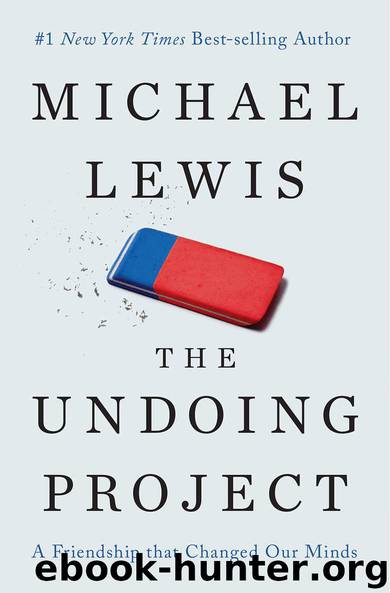The Undoing Project: A Friendship That Changed Our Minds by Michael Lewis

Author:Michael Lewis [Lewis, Michael]
Language: eng
Format: epub, azw3
Publisher: W. W. Norton & Company
Published: 2016-12-05T23:00:00+00:00
____the third position?
(check one)
My estimate for the ratio of these two values is:________:1
If you thought that K was, say, twice as likely to appear as the first letter of an English word than as the third letter, you checked the first box and wrote your estimate as 2:1. This was what the typical person did, as it happens. Danny and Amos replicated the demonstration with other letters—R, L, N, and V. Those letters all appeared more frequently as the third letter in an English word than as the first letter—by a ratio of two to one. Once again, people’s judgment was, systematically, very wrong. And it was wrong, Danny and Amos now proposed, because it was distorted by memory. It was simply easier to recall words that start with K than to recall words with K as their third letter.
The more easily people can call some scenario to mind—the more available it is to them—the more probable they find it to be. Any fact or incident that was especially vivid, or recent, or common—or anything that happened to preoccupy a person—was likely to be recalled with special ease, and so be disproportionately weighted in any judgment. Danny and Amos had noticed how oddly, and often unreliably, their own minds recalculated the odds, in light of some recent or memorable experience. For instance, after they drove past a gruesome car crash on the highway, they slowed down: Their sense of the odds of being in a crash had changed. After seeing a movie that dramatizes nuclear war, they worried more about nuclear war; indeed, they felt that it was more likely to happen. The sheer volatility of people’s judgment of the odds—their sense of the odds could be changed by two hours in a movie theater—told you something about the reliability of the mechanism that judged those odds.
They went on to describe nine other equally odd mini-experiments that got at various tricks that memory might play on judgment. Danny thought of them as very much like the optical illusions the Gestalt psychologists he had loved in his youth planted in their texts. You saw them and were fooled by them and wanted to know why. He and Amos were dramatizing tricks of the mind rather than tricks of the eye, but the effect was similar, and the material available to them appeared to be even more abundant. They read lists of people’s names to Oregon students, for instance. Thirty-nine names, read at a rate of two seconds per name. The names were all easily identifiable as male or female. A few were the names of famous people—Elisabeth Taylor, Richard Nixon. A few were names of slightly less famous people—Lana Turner, William Fulbright. One list consisted of nineteen male names and twenty female names, the other of twenty female names and nineteen male names. The list that had more female names on it had more names of famous men, and the list that had more male names on it contained the names of more famous women.
Download
The Undoing Project: A Friendship That Changed Our Minds by Michael Lewis.azw3
This site does not store any files on its server. We only index and link to content provided by other sites. Please contact the content providers to delete copyright contents if any and email us, we'll remove relevant links or contents immediately.
Hit Refresh by Satya Nadella(8996)
When Breath Becomes Air by Paul Kalanithi(8265)
The Girl Without a Voice by Casey Watson(7776)
A Court of Wings and Ruin by Sarah J. Maas(7561)
Do No Harm Stories of Life, Death and Brain Surgery by Henry Marsh(6840)
Shoe Dog by Phil Knight(5080)
Hunger by Roxane Gay(4831)
A Higher Loyalty: Truth, Lies, and Leadership by James Comey(4797)
The Rules Do Not Apply by Ariel Levy(4789)
Everything Happens for a Reason by Kate Bowler(4612)
Tuesdays with Morrie by Mitch Albom(4600)
The Immortal Life of Henrietta Lacks by Rebecca Skloot(4447)
Millionaire: The Philanderer, Gambler, and Duelist Who Invented Modern Finance by Janet Gleeson(4300)
How to Change Your Mind by Michael Pollan(4256)
All Creatures Great and Small by James Herriot(4190)
The Money Culture by Michael Lewis(4027)
Man and His Symbols by Carl Gustav Jung(4009)
Elon Musk by Ashlee Vance(3987)
Tokyo Vice: An American Reporter on the Police Beat in Japan by Jake Adelstein(3901)
